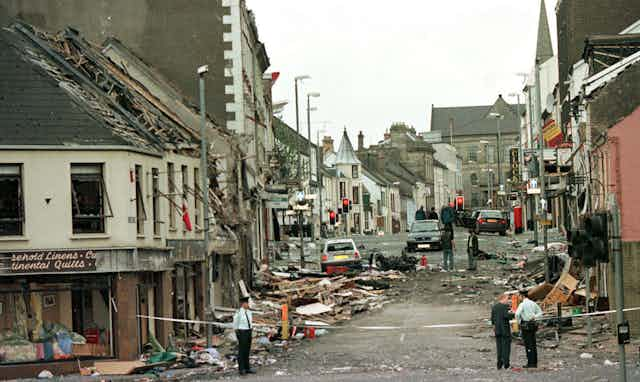Celebrating a quarter century of “peace” since the signing of the Good Friday Agreement will undoubtedly lead many to question how much things have really changed for the better in Northern Ireland. Especially since segregation remains the norm in many areas of life, including housing and education. Attention will once again turn to the Troubles and its legacy.
Between 1968 and 1998 more than 3,700 people were killed and up to 100,000 injured. It was the job of the Northern Ireland health service to treat the wounded while continuing to provide healthcare for all the other medical needs of the population.

In my research for an upcoming book, I interviewed former healthcare workers who lived and worked during the Troubles.
As a medical historian I wanted to explore how the conflict had an impact on the health service, both on its operation and its workers. Their experiences are often overlooked, but provide us with vital insight into the conflict itself and its enduring legacies.
In times of war, healthcare is put under tremendous strain. People are not always able to reach hospitals, and money normally used to pay for services is often diverted for other purposes.
In Northern Ireland, the Troubles affected hospitals and other community services. Because money was being used to treat victims, there were concerns that other patients were losing out. A nurse from the Royal Victoria Hospital in Belfast explained that patients attending for routine operations would often be sent home when the injured came in needing emergency surgery.
Hospitals were also damaged in the violence. In 1991 a bomb exploded at Musgrave Park Hospital in Belfast, killing two people and injuring 10 others. The damage put hospital beds out of use and cost around a quarter of a million pounds to rebuild the damaged orthodpaedic wing.

Medical progress through trauma
The Troubles resulted in many injuries which medical staff had little or no experience of dealing with. Major incidents had a huge emotional impact and brought new medical challenges. But many spoke of learning from these traumatic experiences. They all condemned the horrors and destruction, but were thankful for the knowledge they gained to help others.
These experiences led to lifesaving new medical innovations. One was the development of titanium plates to repair skulls damaged by gunshot wounds or bomb injuries. The use of high velocity weapons during the early 1970s and the significant number of gunshot head wounds created a need that had to be urgently addressed.
At the Royal Victoria Hospital, neurosurgeon Derek Gordon and dentist George Blair combined their different expertise to devise a new kind of skull plate. Their new design made from titanium was light, strong, flexible and relatively inexpensive to make. The new approach proved successful and was used worldwide.
Mental health
One of the most significant legacies from the Troubles was the impact on mental health. Northern Ireland has the highest level of poor mental health in the UK. These levels have been linked directly to the conflict.
The country also has the highest suicide rate in the UK and a significantly higher percentage of prescriptions for drugs to treat anxiety and depression than the rest of the UK. Then there is the challenge of younger generations “inheriting” poor mental health, through the effects on parenting and the environment they grow up in.
Research has shown that substance abuse is a deeply entrenched social problem in Northern Ireland. Similar to prescription drugs, alcohol has been used as a coping mechanism by many, again presenting a challenge and additional cost to the health service.
Medical staff had to cope with emotional effects of working in a bloody conflict, witnessing firsthand the horrifying injuries and deaths caused by the violence. One doctor described his experience:
Some things were too horrible to be forgettable and even today, talking about or even thinking about them brings on the tears. I still waken during the night with terrible dreams about those days.
Yet staff were expected to have a “get on with the job” attitude. There was a commonly held belief that healthcare staff were immune to the effects, and many did not seek help. Some felt it would frowned on while others thought it would be insulting to the victims of the violence, believing those directly affected had it much worse.

There was also a lack of services available to staff. This only changed after the Omagh bomb in 1998. Instead, medical staff created their own coping methods. Interviewees spoke of how they counselled one another over cups of tea and organised social events, or used black humour to keep them going. One interviewee explained:
[The period] wasn’t overly pleasant, but it was life and we lived that life … and managed to have some laughs too, usually at the antics of ourselves.
In May 2008, The Northern Ireland Commission for Victims and Survivors was established to advocate for the needs of Northern Ireland people. However, there continue to be concerns about the funding and availability of mental health services. In response a number of charitable organisations now provide care and support.
Overall, my research revealed that the health service in Northern Ireland was hugely affected by the conflict, chiefly the damaging effect of the bloody violence on the mental health of medical workers as well as the general population. Positive aspects, such as the creation of innovative medical techniques, came at a high cost.
Still, many healthcare workers I spoke to look back fondly on their careers during this period. They despised the violence, but appreciated the opportunity to help victims and survivors, while cherishing the strong bonds they forged with colleagues.

